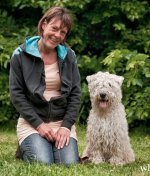Image #1 - "Fill the Frame". Nice shot of a woman and a dog but it illustrates a common problem in portrait photography - the subject needs to fill the frame. Only ~20% of portrait photography involves the entire body, typically a portrait will be head, or head/shoulders, or waist up to head, etc. Often, the only time you get full body shots is when you're shooting to capture the wedding dress and when they do, they fill the frame with the subject. So unless the background is part of the overall story of your shot, filling the frame up with your subject should be the first thing that enters your mind when you go to compose a portrait. And unless a whole body shot is important, consider recomposing to a obtain a tighter shot.
View attachment 39442
Image #2 - "Fill flash and or reflectors" - The high nature of the sun and the placement of your subject relative to this light has cast a dark shadow on your subject and causing your to underexpose your image. Part of the problem is matrix metering, it will try to average out the amount of light in any shot, which is great most of the time but in cases like this it fails. When you find your subject is in the shadows relative to the background you need to use a fill-flash or a reflector to bring light back in on your subject. The other alternative to fill-flash and reflectors is to recompose. Put the subject somewhere with more even light with less of a contrast and also remember to "Fill the Frame"
btw - if you find yourself in this predicament and you don't have a flash or reflector and you can't move and recompose, use HDR. HDR would not be my first choice but it works great in a pinch.
Image #3 - "Avoid Back-lit subjects" - Similar to Image #2, your subject is in the shadows while your background is bright and sunny. Because your subject is not partially in the sun and shadow, she shows up better than in Image #2 but she is still underexposed. A fill-flash or reflector would have done wonders for this shot. Also, don't forget to "Fill the Frame"
Image #2 and #3 both could have been avoided had you moved your subjects slightly one way or the other. The key is to identify these issues before you get to the computer stage. Here's a little list I have in my head when I'm doing portraits.
1- Fill the frame with the subject unless the background is part of the story
2- Avoid backlit compositions and when confronted with them, use fill-light or reflectors
3- Eyes are 70% of a good portrait. People often use fill-flash regardless of where they're shooting just to bring out the catch-lights in the eyes. If you can't see your subject's eyes, be sure there's a good reason for it. If there isn't, recompose the scene.
4- Never place the subject higher than the camera and have them to look down at you. This causes necks to look twice their normal size as well as causes the subjects face to look much fatter.
5- Try to position your subject so that the head is slightly turned relative to the body, this elongates the neck and removes wrinkles as well as lowers the shoulders. Lower shoulders give the appearance of a relaxed subject and the last thing you want is your subject to look tense and unnatural.
6- Always check their hands/fingers before taking the shot. Hands and fingers are so easy to overlook during the shoot but once you get to the computer they jump out screaming at you. Always, always always check the hands and fingers to make sure they look natural and relaxed, otherwise you'll end up with an almost great photo instead of a great photo.
There are a few more things to check for when doing portraits but these are perhaps my top 6. Hopefully this helps.









